NCERT Solutions for Class 10 Science Chapter 12 - Magnetic Effects of Electric Current
| Table of contents |

|
| Page No: 196 |

|
| Page No: 201 |

|
| Page No: 202 |

|
| Page No: 203 |

|
| Page No: 204 |

|
| Page No: 205 |

|
| Page No: 207 |

|
Page No: 196
Q1: Why does a compass needle get deflected when brought near a bar magnet?
Ans: The needle of a compass is a small magnet. That’s why when a compass needle is brought near a bar magnet, its magnetic field lines interact with that of the bar magnet. Hence, a compass needle gets deflected.
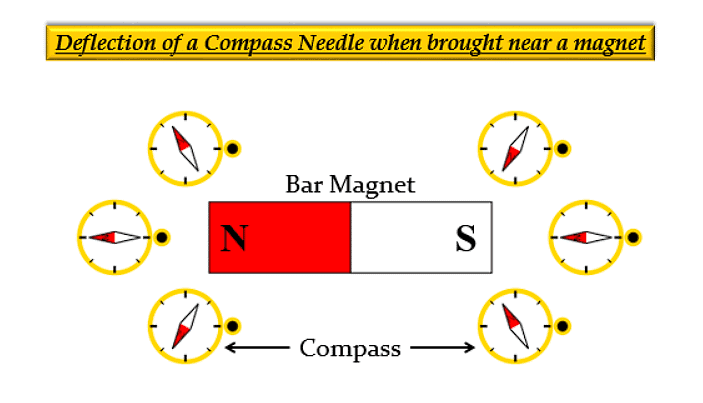 Page No: 200
Page No: 200
Q1: Draw magnetic field lines around a bar magnet.
Ans: Magnetic field lines of a bar magnet emerge from the north pole and terminate at the south pole. Inside the magnet, the field lines emerge from the south pole and terminate at the north pole, as shown in the given figure. Magnetic Field Lines
Magnetic Field Lines
Q2: List the properties of magnetic field lines.
Ans: Properties of magnetic lines of force –
- The magnetic field lines originate from the north pole of a magnet and end at its south pole.
- The magnetic field lines become closer to each other near the poles of a magnet but they are widely separated at other places.
- Two magnetic field lines do not intersect one another.
Q3: Why don’t two magnetic field lines intersect each other?
Ans: If two magnetic field lines of force intersect each other then at the point of intersection, the compass needle would show two different directions which is not possible.
Page No: 201
Q1: Consider a circular loop of wire lying in the plane of the table. Let the current pass through the loop clockwise. Apply the right-hand rule to find out the direction of the magnetic field inside and outside the loop.
Ans: Inside the loop = Pierce inside the table
Outside the loop = Appear to emerge out from the table
For downward direction of current flowing in the circular loop, the direction of magnetic field lines will be as if they are emerging from the table outside the loop and merging in the table inside the loop. Similarly, for upward direction of current flowing in the circular loop, the direction of magnetic field lines will be as if they are emerging from the table outside the loop and merging in the table inside the loop, as shown in the given figure.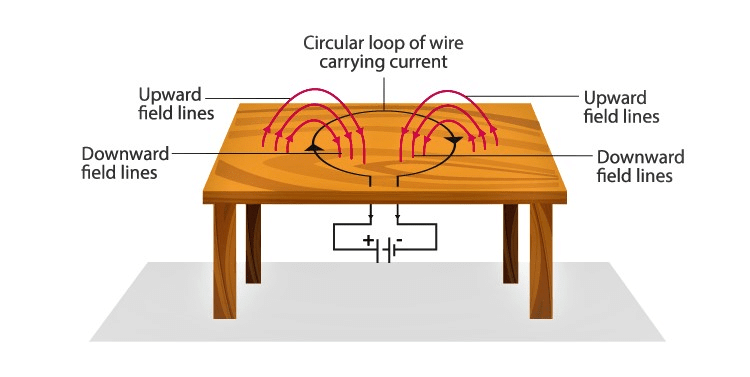
Q2: The magnetic field in a given region is uniform. Draw a diagram to represent it.
Ans:
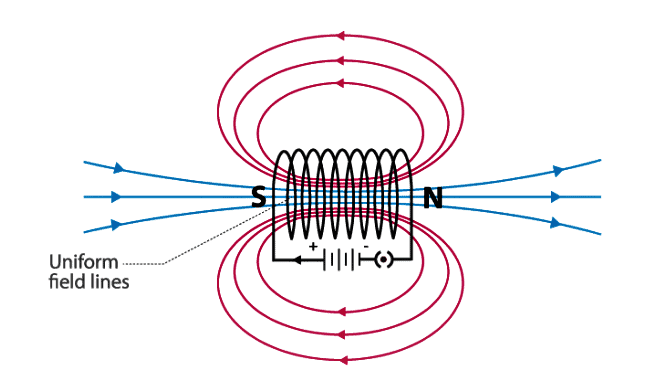 Magnetic Field The magnetic field lines inside a current-carrying long straight solenoid are uniform.
Magnetic Field The magnetic field lines inside a current-carrying long straight solenoid are uniform.
Page No: 202
Q1: Choose the correct option.
The magnetic field inside a long straight solenoid-carrying current
(a) is zero
(b) decreases as we move towards its end
(c) increases as we move towards its end
(d) is the same at all points
Ans: (d)
Sol: The magnetic field inside a long straight current-carrying solenoid is uniform therefore it is the same at all points.
Page No: 203
Q1: Which of the following property of a proton can change while it moves freely in a magnetic field? (There may be more than one correct answer.)
(a) mass
(b) speed
(c) velocity
(d) momentum
Ans: (c)
Sol: When a proton enters the region of magnetic field, it experiences magnetic force. Due to which the path of the proton becomes circular. As a result, the velocity and the momentum change.
Page No: 204
Q1: In Activity 12.7, How do we think the displacement of rod AB will be affected if, (i) – current in rod AB is increased; (ii) – a stronger horse-shoe magnet is used; and (iii) – length of the rod AB is increased?
Ans: (i) When the current in the rod AB is increased, force exerted on the conductor increases, so the displacement of the rod increases.
(ii) When a stronger horse-shoe magnet is used, the magnitude of the magnetic field increases. This increases the force exerted on the rod and the displacement of the rod.
(iii) When the length of the rod AB is increased, force exerted on the conductor increases, so the displacement of the rod increases.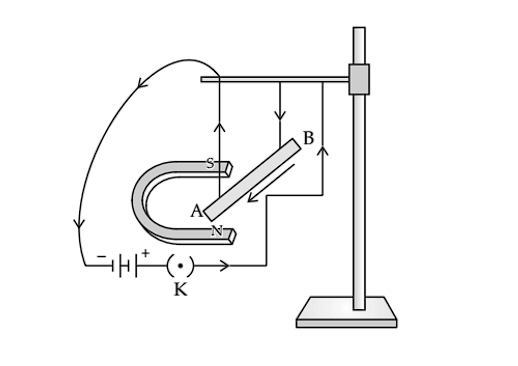 Displacement of Rod Q2: A positively-charged particle (alpha-particle) projected towards west is deflected towards north by a magnetic field. The direction of magnetic field is
Displacement of Rod Q2: A positively-charged particle (alpha-particle) projected towards west is deflected towards north by a magnetic field. The direction of magnetic field is
(a) towards south
(b) towards east
(c) downward
(d) upward
Ans: (d)
Sol: The direction of the magnetic field can be determined using Fleming’s Left-hand rule. According to the rule, if we arrange our thumb, forefinger and the middle finger of the left-hand right perpendicular to each other, then the thumb points towards the direction of the magnetic force, the middle finger the direction of current and the forefinger the direction of the magnetic field. Since the direction of positively charged particle is towards west, the direction of the current will also be towards the west. The direction of the magnetic force is towards the north, hence the direction of the magnetic field will be upward according to Fleming’s Left-hand rule.
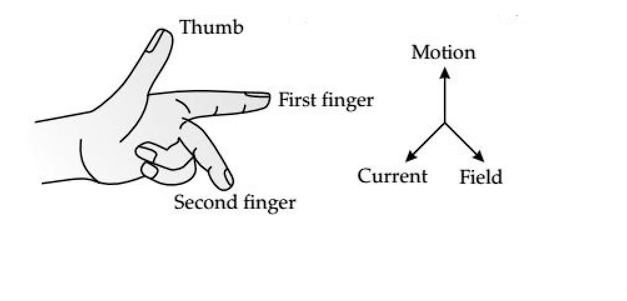 Left - Hand Rule
Left - Hand Rule
Page No: 205
Q1: Name two safety measures commonly used in electric circuits and appliances.
Ans: Two safety measures commonly used in electric circuits and appliances are
- Electric Fuse: An electric fuse is connected in series it protects the circuit from overloading and prevents it from short-circuiting.
- Proper earthing of all electric circuit in which any leakage of current in an electric appliance is transferred to the ground and people using the appliance do not get the shock.
Q2: An electric oven of 2 kW power rating is operated in a domestic electric circuit (220 V) that has a current rating of 5 A. What result do you expect? Explain.
Ans: The current drawn by the electric oven,
I = P/V
Substituting the values,
I = 2000/220 = 9.09 A
The current drawn by the electric oven is 9.09 A which exceeds the safe limit of the circuit.
Due to excessive current, the fuse wire will blow and the circuit will break.
Q3: What precaution should be taken to avoid the overloading of domestic electric circuits?
Ans:The precautions that should be taken to avoid the overloading of domestic circuits are as follows:
- Too many appliances should not be connected to a single socket.
- Too many appliances should not be used at the same time.
- Faulty appliances should not be connected in the circuit.
- Fuse should be connected in the circuit.
Page No: 207
Exercise
Q1: Which of the following correctly describes the magnetic field near a long straight wire?
(a) The field consists of straight lines perpendicular to the wire
(b) The field consists of straight lines parallel to the wire
(c) The field consists of radial lines originating from the wire
(d) The field consists of concentric circles centred on the wire
Ans: (d)
Sol: The magnetic field near a long straight wire are concentric circles. Their centers lie on the wire.
Q2: At the time of short circuit, the current in the circuit
(a) reduces substantially
(b) does not change
(c) increases heavily
(d) vary continuously
Ans: (c) increases heavily
Sol: When two naked wires in the circuit come in contact with each other, the amount of current flowing in the circuit increase abruptly resulting in short circuit.
Q3. State whether the following statements are true or false.
(a) The field at the centre of a long circular coil carrying current will be parallel straight lines.
Ans: True
A long circular coil is a solenoid. The magnetic field lines inside a solenoid are parallel straight lines.
(b) A wire with a green insulation is usually the live wire of an electric supply.
Ans: False
Live wire has red insulation cover, whereas earth wire has green insulation colour in the domestic circuits.
Q4: List two methods of producing magnetic fields.
Ans: Two methods of producing magnetic fields are:
(i) The permanent magnet produces a magnetic field around it.
(ii) Passing current through a conductor also produces the magnetic field.
Q5: When is the force experienced by a current–carrying conductor placed in a magnetic field largest?
Ans: The force experienced by a current-carrying conductor is largest when the direction of the current is perpendicular to the direction of the magnetic field.
Q6: Imagine that you are sitting in a chamber with your back to one wall. An electron beam, moving horizontally from back wall towards the front wall, is deflected by a strong magnetic field to your right side. What is the direction of magnetic field?
Ans: The direction of the magnetic field is vertically downwards. The direction of current is from the front wall to the back wall because negatively charged electrons are moving from the back wall to the front wall. The direction of magnetic force is rightward. Hence, using Fleming’s left hand rule, it can be concluded that the direction of magnetic field inside the chamber is downward.
Q7: State the rule to determine the direction of a (i) magnetic field produced around a straight conductor-carrying current, (ii) force experienced by a current-carrying straight conductor placed in a magnetic field which is perpendicular to it, and (iii) current induced in a coil due to its rotation in a magnetic field.
Ans: (i) The rule used to determine the direction of the magnetic field produced around a straight conductor-carrying current is Maxwell’s right-hand thumb rule.
(ii) The rule used to determine the force experienced by a current-carrying straight conductor placed in a magnetic field that is perpendicular to it is Fleming’s left-hand rule.
(iii) The rule used to determine the current induced in a coil due to its rotation in a magnetic field is Fleming’s right-hand rule.
Q8: When does an electric short circuit occur?
Ans: Listed below are two instances of when a short-circuit can occur:
(i) When too many appliances are connected to a single socket or when high power rating appliances are connected to a light circuit, the resistance of the circuit becomes low as a result the current flowing through the circuit becomes very high. This condition results in a short circuit.
(ii) When live wires whose insulation have worn off come in contact with each other, the current flowing in the circuit increases abruptly which results in a short circuit.
Q9: What is the function of an earth wire? Why is it necessary to earth metallic appliances?
Ans: It is necessary to earth metallic appliances because it ensures that if there is any current leakage in the metallic cover, the potential of the appliance becomes equal to that of the earth. The potential of the earth is zero. As a result, the person handling the appliance will not get an electric shock.
|
80 videos|569 docs|80 tests
|
FAQs on NCERT Solutions for Class 10 Science Chapter 12 - Magnetic Effects of Electric Current
| 1. What is the magnetic effect of electric current? |  |
| 2. How does a current-carrying conductor produce a magnetic field? |  |
| 3. What are the applications of the magnetic effect of electric current? |  |
| 4. How does an electric motor work based on the magnetic effect of electric current? |  |
| 5. What is the difference between AC and DC in terms of the magnetic effect of electric current? |  |
















